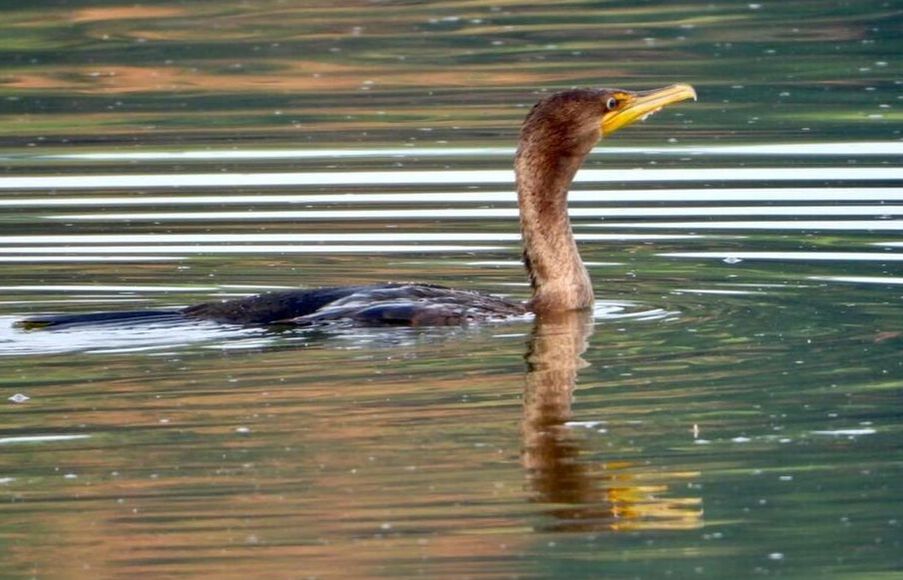As cormorant numbers rebound in certain parts of region, updated data would help assess their impact9/30/2022 As someone who spends lots of time on the Susquehanna River as a professional fishing guide and owner of Southside Sports bait shop in Sunbury, Ken Maurer is increasingly concerned about the number of cormorants he sees regularly at the Adam T. Bower Memorial Dam below Sunbury. “We have a flock of about a hundred that live at the fabridam,” he said. “They are here for at least eight months out of the year, and they eat a pound to a pound-and-a-half of fish each day per bird. That would add up to a staggering 24,000 pounds of fish eaten if 100 birds are here at least 240 days of the year.” Cormorants are dark, slender birds equipped to live in and around water – with webbed feet and a long bill with a hooked end, according to naturalist Jon Beam, who suggested that since they breed in colonies that can number “from a few to thousands,” they can have an impact on the environment where they nest.
“Their acidic droppings can kill understory vegetation and through time will damage and kill nest trees,” he said. “They can also out-compete other water birds, particularly herons, for nest sites.” Cormorants feed almost exclusively on fish, although they do eat crustaceans, according to Beam. According to the USDA’s Wildlife Management Services, and adult cormorant will eat approximately 19 ounces of fish per day – mainly forage fish that range in size between six to eight inches. According to Pennsylvania Fish and Boat Commission biologist Geoffrey Smith, cormorants are not invasive to the region. “I am pretty sure they are native in our system, although maybe not in the abundance some see in certain spots,” he said. “They’ve been known to eat a variety of items, not specializing in one sort of fish species, but instead eating what is most plentiful in the region. We did find smallmouths in their diet in one study, but that was only like in one percent. When it comes to eating, they are generalists.” Cormorants are expert divers, typically plunging to depths of 10 to 25 feet and can stay underwater searching for food for more than a minute per dive. One of the reasons they are so much more noticeable than some other water-focused species, according to Beam, is due to the makeup of their feathers. “Because they don’t produce the amount of oil as do other diving birds, the feathers of cormorants hold water and can become water-logged,” Beam said. “Cormorants typically perch with their wings outstretched for periods of time to dry their feathers.” According to Smith, cormorants are beginning to re-colonize certain regions of the watershed, which has led to increased sightings in specific areas. “Much like eagles, cormorant populations in our region were wiped out, we think, by DDT,” he said. “As the population rebounds, they can come back with more of a fury due to open niche space, although there hasn’t been a lot of research on this.” According to Dan Brauning, who was involved in the Pennsylvania Game Commission’s efforts to restore eagle and osprey populations, there is not sufficient data to suggest that increasing cormorant numbers are over-taxing the river’s fishery. “While that may be the case in some locations where wintering birds concentrate around fish-farming facilities, or possibly around breeding colonies, we don't have sufficient populations here in central PA to impact fish on the Susquehanna River branches,” he said. Cormorants are protected by the US Fish and Wildlife Service under migratory bird regulations. As of February 2021, the US Fish and Wildlife Service issued management rules and permits for controlling double-crested cormorant populations in certain circumstances. “Other states have gotten permits to reduce their numbers as they are federally protected, but here we have done nothing other than a small ineffectual culling of a few that were endangering other avian predators at a small island near Harrisburg,” said Maurer. Considering the species’ recent population increases in specific sections of the river, it might time to re-evaluate their impacts on the aquatic ecosystem in those areas to proactively determine a safe population threshold, so the pendulum doesn’t swing too far in the opposite direction.
1 Comment
Kenneth Maurer
10/7/2022 06:17:17 pm
I'm pretty sure they are not native. On the St. Lawrence river, they have defoliated islands. On many waters they have effected fish populations. On the Susquehanna, they get a weak kneed "I don't think they are hurting anything" defense. So they keep eating thousands of pounds of fish, and its okay I guess.
Reply
Leave a Reply. |
AuthorsRiverkeeper John Zaktansky is an award-winning journalist and avid promoter of the outdoors who loves camping, kayaking, fishing and hunting with the family. Archives
July 2024
Topics |

 RSS Feed
RSS Feed